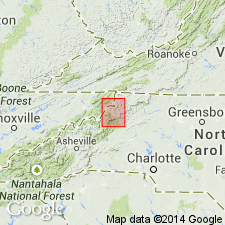
- Usage in publication:
-
- Blowing Rock gneiss*
- Modifications:
-
- Named
- Dominant lithology:
-
- Gneiss
- AAPG geologic province:
-
- Piedmont-Blue Ridge province
Summary:
Name Blowing Rock gneiss introduced for unit in Cranberry quad, Watauga Co., western NC. Consists wholly of gneiss of two varieties, one with large porphyritic feldspar crystals, the other of very fine, even grain. In places the two varieties grade into each other; in other places they are repeatedly interbedded. Cuts Carolina gneiss and appears to cut the still younger Cranberry granite. Age is Precambrian.
Source: GNU records (USGS DDS-6; Reston GNULEX).
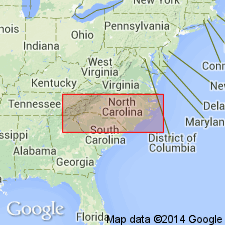
- Usage in publication:
-
- Blowing Rock gneiss
- Modifications:
-
- Overview
- AAPG geologic province:
-
- Piedmont-Blue Ridge province
Summary:
Mapped as Blowing Rock gneiss. Consists of two varieties, one containing large porphyritic crystals of orthoclase feldspar embedded in groundmass of quartz, feldspar, biotite, and muscovite, and the other consisting of the same minerals in grains of uniform size. Age is Precambrian.
Source: GNU records (USGS DDS-6; Reston GNULEX).
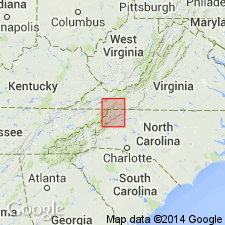
- Usage in publication:
-
- Blowing Rock Gneiss*
- Modifications:
-
- Areal extent
- Overview
- AAPG geologic province:
-
- Piedmont-Blue Ridge province
Summary:
Mapped in Grandfather Mountain window as part of the informal Elk Park plutonic group in Caldwell and Watauga Cos., northwestern NC. Consists of very coarse-grained augen gneiss containing microcline porphyroblasts averaging 2 to 4 cm long. Locally grades to Wilson Creek Gneiss and includes equigranular quartz monzonite gneiss resembling Wilson Creek Gneiss. Age is early Precambrian.
Source: GNU records (USGS DDS-6; Reston GNULEX).
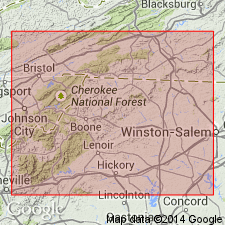
- Usage in publication:
-
- Blowing Rock Gneiss
- Modifications:
-
- Geochronologic dating
- AAPG geologic province:
-
- Piedmont-Blue Ridge province
Summary:
Rb-Sr age of 1,027+/-36 m.y. determined for Blowing Rock Gneiss.
Source: GNU records (USGS DDS-6; Reston GNULEX).
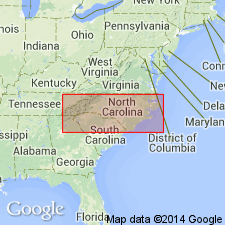
- Usage in publication:
-
- Blowing Rock Gneiss
- Modifications:
-
- Overview
- AAPG geologic province:
-
- Piedmont-Blue Ridge province
Summary:
Middle Proterozoic Blowing Rock Gneiss mapped in Grandfather Mountain window. Consists of abundant white potassic feldspar megacrysts in finely banded biotite schist, locally calcareous; interlayered with quartz-feldspar schist, calcareous biotite schist, phyllite, black slate, calcareous quartzite, sulfidic greenstone, and siliceous tuff. Unconformably underlies Late Proterozoic Grandfather Mountain Formation.
Source: GNU records (USGS DDS-6; Reston GNULEX).
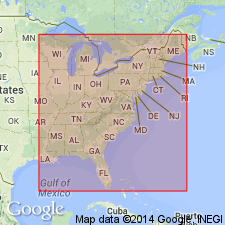
- Usage in publication:
-
- Blowing Rock Gneiss*
- Modifications:
-
- Geochronologic dating
- AAPG geologic province:
-
- Piedmont-Blue Ridge province
Summary:
Isotopic ages of Blowing Rock Gneiss are as follows: 206Pb-238U age of 981 Ma, 207Pb-235U age of 997 Ma, and 207Pb-206Pb age of 1033 Ma (Davis and others, 1962), and Rb-Sr whole rock isochron age of 1005 Ma (Fullagar and Odom, 1973).
Source: GNU records (USGS DDS-6; Reston GNULEX).
For more information, please contact Nancy Stamm, Geologic Names Committee Secretary.
Asterisk (*) indicates published by U.S. Geological Survey authors.
"No current usage" (†) implies that a name has been abandoned or has fallen into disuse. Former usage and, if known, replacement name given in parentheses ( ).
Slash (/) indicates name conflicts with nomenclatural guidelines (CSN, 1933; ACSN, 1961, 1970; NACSN, 1983, 2005, 2021). May be explained within brackets ([ ]).

